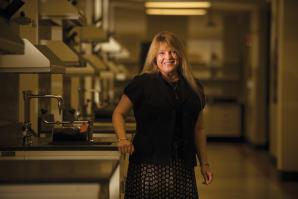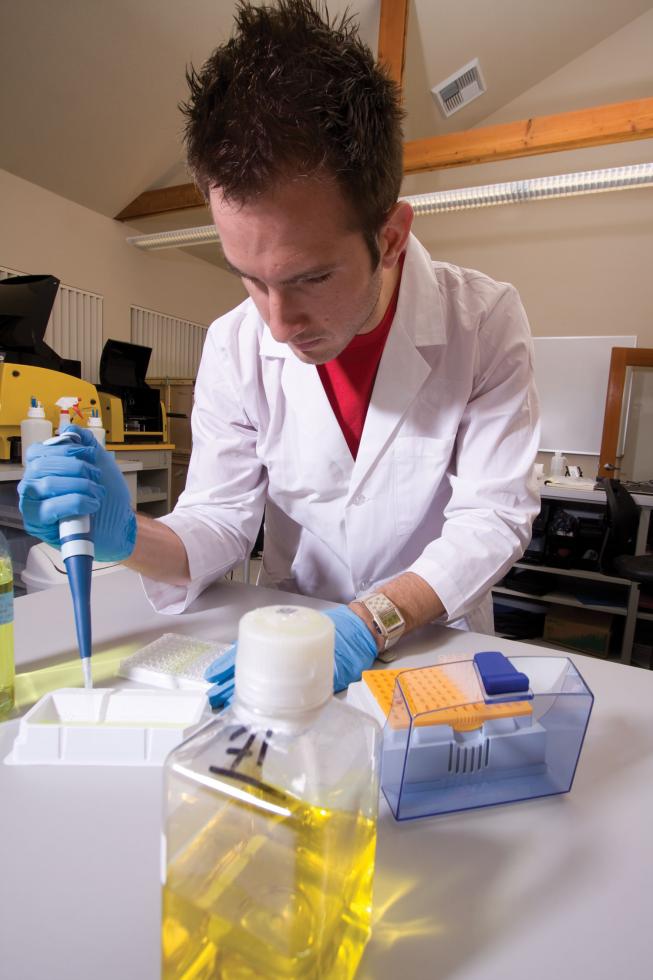The team at Davis-based Gold Standard Diagnostics Inc., which sells disease test kits, automated instruments and regulatory services, noticed an opportunity in the medical laboratory industry to build an instrument that would automate not only the test kits it was offering, but those of other suppliers as well, allowing labs to consolidate to one instrument and improve efficiency, says John Griffiths, chief executive officer.
So Griffiths and his associates scraped together some money from family members, friends and their own pockets and built and tested a prototype.
“It’s like having a razor that any blade on the market could fit on or a printer that any cartridge could fit on,” Griffiths says. “This saves the labs money and allows for quicker turnaround time. Insurance companies like it, the labs like it, doctors like it and patients like it.”
Turns out, angel investors like it too. With their help, the company was able to expand and go into production. Two years later, the company is “in a position where there’s more demand for this instrument than what we can make,” Griffiths says.
Griffith’s team did several things right. They saw a need for their potential product, found a way to build the product and prove that it worked before seeking investors, earned cash-flow by running a business while building the new product, and built up a good rapport with a trusting customer base before selling their product.
But the experience of getting a new medical device to market isn’t always this smooth. In fact, many med tech projects fizzle at the idea stage, partly because of funding.
In 2010, venture capital investment in the medical device industry fell 9 percent and was flat in terms of deals with $2.3 billion going into 324 deals, according to PricewaterhouseCoopers’ annual MoneyTree Report.
This is despite an increase of 19 percent in dollars and a 12 percent rise in deals for venture capitalists’ investments across all industries — $21.8 billion in 3,277 deals. This was the first time the annual investment level has increased since 2007.
In the fourth quarter of 2010, overall investments saw a 2 percent increase in dollars from the previous quarter, but medical devices saw a drop of 31 percent with $400 million going into 71 deals. Of that, Silicon Valley companies received the most: $119 million in 17 deals. New England companies came in second with $97 million in 11 deals, and the New York metro area followed with $36 million in five deals.
Business leaders, educators, scientists and inventors are taking notice. New medical technologies could more accurately diagnose, cure and even avert disease; prevent and repair injuries; get people back to work faster and, consequently, reduce costs.
“If you have tools to help you start a healthy lifestyle, start monitoring early and start managing your sickness early, the benefit to the public is obvious,” says Gopan Madathil, president of TechCoire, a technology industry group, and president of InvestorFest Media Inc, an organization that connects the life sciences and medical device industries with investors.
A few specific areas where medical technology could be useful are simplified diagnostic tests, tools for less-invasive surgeries and screenings and anything dealing with some of America’s top health problems, such as cardiovascular disease, diabetes and Alzheimer’s.
Madathil uses an example of a company developing a diabetes test monitor that uses a wireless network. When the patient tests blood sugar, it automatically sends the information to the doctor’s office.
Future opportunities in the Capital Region could include telemedicine, regenerative medicine and molecular imaging, says Cary Adams, a former attorney who founded Proximal Ventures in 2008 to focus on venture funding for health care companies. He was also the founding president of the Sacramento Angels (a group that invests in early-stage Northern California companies), the founding chairman of the Sacramento Area Regional Technology Alliance and now the chair of SARTA’s MedStart industry group.
But funding such technology is not only expensive, it’s risky.
“It takes a lot of money to prove safety and efficacy, satisfy the regulatory authorities, manufacture new products and make them generally available, then convince doctors, health systems and payers to change their practices to incorporate innovation,” Adams says.
Griffiths says: “We have found that, going to venture companies, if we can’t show them a growth rate of $100 million in a few years, it’s not interesting to them.”
Paul Lambert, chairman and CEO of medical device manufacturer EMED Technologies Corp. in El Dorado Hills, says the combination of cost and government regulations can be a hang-up to funding. He cites examples of companies that needed $100,000 to $2 million just to get an idea ready for human trial. “Then the FDA will make it a very tough process of one, two or three years of regulatory scrutiny. … Even though the yield and the returns can be more lucrative, no venture capital will want to fund an idea when it may take five years for it to happen, and in those five years the company may die.”
Madathil says this is why, over the past two to three years, some companies have been circumventing the Food and Drug Administration process and instead testing in other countries. He notes that India has become the world’s largest pharmaceutical trial market, and trials for medical devices are rapidly growing in Eastern Europe “where there are fewer onerous requirements for testing and less chance of a lawsuit.” In fact, many in the industry fear that companies are heading toward a trend of moving their entire operations overseas.
“For a new medical device company starting out, we could probably pay more in taxes than we make in profit.”
John Griffiths, chief executive officer, Gold Standard Diagnostics Inc.
Further complicating the issue are uncertainties surrounding federal health care reform. The FDA has begun a multiyear process of changing how it approves medical devices, Adams says. But the uncertainty of the law’s finality makes it difficult to predict the timeline for FDA approval or how much a product can be sold for in the future. “This makes the investor’s calculations of projected return — to be balanced against the risks — more difficult to quantify,” he says.
Another potential wrench health care reform may throw is new limits to certain forms of marketing for new medical products, Lambert says. “It should be made public how new devices can contribute to simplifying and lowering costs,” he says.
Griffiths worries about the 2.3 percent medical device excise tax. “It’s not on your earnings; it’s on your total revenue,” he says. “So for a new medical device company starting out, we could probably pay more in taxes than we make in profit.”
And the economy is still bouncing back. Griffiths recalls 2006 when venture funding across industries was thriving. “About 35 percent of venture capitals had money under management, and now it’s about 12 percent,” he says.
Adams says the financial meltdown from 2008 to 2010 had a particularly devastating effect on medical technology. “Investors wanting to make money in med tech have, over the last two years, been able to invest in later-stage med tech companies at seed-stage valuations. But unless there are seed-stage investors, the pipeline will run dry in a couple years,” he says.
Despite the challenges, there are few things medical technology companies can do to improve their success. One is to look in the right places for investors. “If you’re starting a medical device company here in Sacramento, you’ve got to go to the Bay Area to get funding,” Madathil says. “That’s where the money is.”
Lambert points out the need for frugality. “I can’t tell you how many CEOs I’ve met here who have wonderful devices and use up $3 [million] to $5 million of their initial round just to complete the development,” he says. “Then their investors are upset because they didn’t deliver what they promised. It’s not because they didn’t apply themselves. It’s because they were not aware of some of the things they should have been aware of.”
He adds taking advantage of local organizations like SARTA — with a variety of education, networking and showcase programs — can dramatically increase the odds of success for startups.
“Through MedStart, we’ve identified a whole community of experts who are looking for their next opportunity, and a number of them have contributed to our local startups and are available to help others,” Adams says. “We’re also planning a design and innovation center where expensive equipment and best practices can be shared across multiple projects, so people aren’t reinventing the wheel.”
Above all, inventors need to start with a good business plan and be prepared to dedicate several years to seeing the new product to market.
“If you’re going to be a startup, you have to know what your market is, know your customers, know what their tolerance level is for what they’re going to pay for and who your competitors are,” Griffiths says. “Why does somebody need you? If you can’t answer that, then you probably only have a good idea that may not be sellable.”
Adams cites an early-stage investing model for med tech pioneered by Wavepoint Ventures in El Dorado Hills: “You need to anticipate that a successful ultimate outcome is going to be an acquisition in the $50 million range — as opposed to 10 times that — so the business plan and early-stage investments need to make sense with that outcome in mind.
“Instead of taking on a large salaried staff, who need to be paid every month and do not have all the skills necessary to succeed, you replace that wherever possible with temporary expert consultants who contribute a small piece of the process for a discrete fee. … When you’re not achieving milestones, e.g., while you’re waiting on the FDA, you can cut back on your run rate,” he says.
Despite the dismal past, there may be some promising signs for the future. Several note recent mergers and acquisitions. “In the first quarter of 2011, we had 11 mergers and acquisitions in the biotech and medical device sector and that represents over $4 billion of activity,” Madathil says.
One example is Medtronic Inc.’s recent $800 million purchase of Mountain View-based Ardian Inc., a developer of catheter-based therapies for hypertension treatment. If successful, the therapy may one day play a role in treating heart failure, insulin resistance and chronic kidney disease.
As for the Capital Region, Madathil says, “we haven’t added any companies, but we haven’t lost any companies in the last 18 months — and that’s a good sign.” Several events aiming to boost the industry are scheduled.
The Second Annual Sacramento Med Tech Showcase was last month. The LifeScienceFest 2011 conference is June 17 in Redwood Shores, where entrepreneurs in the life sciences and medical devices industry can meet and pitch to angels and venture capitalists.
The UC Davis Health System recently launched quarterly forums to focus on unmet medical needs and regional med tech commercialization opportunities. These include presentations by clinicians, inventors, entrepreneurs, engineers and investors.
The forums are part of the Medical Technology Commercialization Clinic, made possible by a Partnerships for Innovation grant from the National Science Foundation. It brings together teams of faculty, physicians, postdoctoral scientists and students pursuing degrees ranging from science, engineering and math to business and law, with experienced entrepreneurs who help mentor participants in developing commercialization strategies. The first forum was April 19, and the series continues on June 9, Sept. 28 and Nov. 30.
Recommended For You

Economic Regeneration
Can stem cells grow the region’s bottom line?
A broken leg used to be a death sentence for a horse. Now, the University of California veterinary teaching hospital in Davis is using stem cells to help the horses heal quickly.

Stemming Out
UC Davis researchers deliver lab innovations
Dr. Jan Nolta is a whirlwind of energy, and this July morning she is blitzing through UC Davis’ brand-new Institute for Regenerative Cures, a state-of-the-art lab where scientists and researchers are working on breakthrough discoveries and stem cell therapies.



